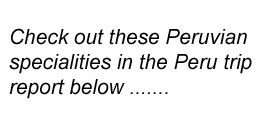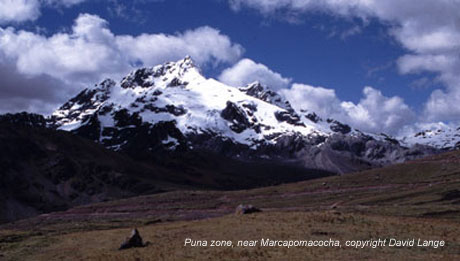
photo by David Lange
Peru, June 3rd-24th, 2000
by David Lange

Introduction
We did a three-week trip to Peru concentrating on the Manu area with a few days near Lima. Our trip leaders were Paul Donahue and Teresa Wood who have spent many years in Peru. Three of us (Patty, Winty and myself) flew from Boston to Miami. There we met Paul and Teresa who had arrived in Miami several days before. Barbara, our sixth starting member, was from Florida. Over the next week, four others (Linda, Irene, Bob and Ted) joined our group on various days. We took a night flight to Lima arriving in the dark.
Paul and Teresa can be contacted through: http://www.nemaine.com/treetopexplorations/bio.html
The first three days of our trip were close to Lima concentrating on a number of endemics. We discussed doing the driving ourselves but that would have required renting two cars as six would be doing this part of the trip. We decided to go with Kolibri Expeditions for transportation and guide which worked very well. They have a large Dodge Ram van with good ground clearance and suspension which was needed on roads we travelled. Our guide, Goyo, knew just where to stop for our targeted birds and our driver, Juvinal, knows the roads well and is an ace driver in Lima. Although it cost a bit more, we had a much better birding experience and certainly more time with the birds.
Kolibri expeditions can be contacted through: http://www.netaccessperu.net/kolibri
The next three days were in the Cusco area with an afternoon at Huacarpay Lakes and two days on Abra Malaga; a wonderful birding area with great changes in elevation, habitat and birdlife in a short distance. For these days, we arranged for a van and driver from InkaNatura and based ourselves in Yucay.
Inkanatura can be contacted through: http://www.inkanatura.com
We then boarded a bus built on a truck chasis giving lots of ground
clearance for the drive from Cusco to Atalaya where we went by river transportation to Manu Wildlife Center. The bus part of the trip was less than two days on the road but we stopped at Cock-of-the-Rock Lodge for three days of birding in the temperate zone. The boat part of the trip was broken up by a full day at Pantiacolla Lodge. Thus decent from Cusco to Manu took a full week giving us some time at different elevations. We stayed six full days at Manu Wildlife Center. Transporation and lodging were arranged through InkaNatura.
To avoid the 3 day land and water trip back out of Manu, we flew out of Boca Manu to Cusco with the flight taking about 45 minutes. We then did a day trip to Machu Picchu. On our last day we took an early flight to Lima where we had the better part of the day available before an evening flight returning to the U.S. We used this time to return to the Santa Eulalia valley with Kolibri Expeditions for an afternoon of birding.
June 3rd, Lomas de Lachay and Pantanes de Villa
Goyo and Juvinal picked us up at the airport and we headed north in the fog to Lomas de Lachay, a nature preserve, a little over an hour away. We arrived at a spot to look for Cactus Canastero shortly after dawn and worked our way up an arroyo finding one about a kilometer away. We picked up Oasis Hummingbird and Grayish Miner before breakfast as well. Then back to the main highway and on to the nature preserve visitor center where the specialty was Thick-billed Miner, where we found two were working around the deer pin. Also around the visitor center, we saw Peruvian Meadowlark, Croaking Ground-Dove, and Short-tailed Field-Tyrant. On the way out, we stopped for a walk across the dry plain to find Least Seedsnipe.
Then back to Lima and on to Pantanos de Villa on the southwest side of Lima along the coast. Over 20 Peruvian Thick-knees highlighted our arrival. We drove to the far side of Pantanos de Villa to some rush lined ponds next to the beach. After watching Peruvian Pelicans and Boobys, Guanay Cormorants, Gray, Band-tailed, Kelp and Gray-headed Gulls, and Inca Terns for several minutes we turned our attention to the ponds. Winty and I had great views of a couple of Many-colored Rush-Tyrants and Winty got great photos as well. Lots of waterbirds including White-tufted, Great and Pied-billed Grebes, 7 species of herons, Puna Ibis, White-cheeked Pintail, Cinnamon Teal, and Plumbeous Rail. By this time it was starting to get dark so into Miraflores for the night.
June 4th, Santa Eulalia valley and Marcapomacocha
Up early and ready to go at the appointed time of 4:30 am, but part of the group forgot about the time zone change so we finally left nearly an hour later than planned. We headed east out of Lima on the central highway to Chosica, then left to Santa Eulalia and on up the valley.

After we had enough light to see things well, a woodpecker flew up to a perch which turned out to be a Black-necked Woodpecker. Whow, what a nice way to start the morning. We spent about half an hour in the area picking up Scrub Blackbird, Cinereous Conebill, and Collared Warbling-Finch. After passing through a small tunnel a few birds flew up next to the road and we started hiking along the road. Peruvian Sheartails were numerous in this area and we also had Sparkling Violet-ear, Giant Hummingbird, Andean Swift, Yellow-billed Tit-Tyrant, Band-tailed Seedeater, and Great Inca-Finch.
Our original plan was to continue up the valley and camp out at about 10,000 feet (3,000 m) and then continue on to Marcapomacocha the following day for Diademed Sandpiper-plover and White-bellied Cinclodes. But a landslide blocked the road so we had to go back to Chosica and then continue on the cental highway to reach Marcapomacocha. Our time was up on the Santa Eulalia valley so we turned around just before the San Pedro bridge, had a late breakfast and started down. We returned to the Santa Eulalia valley on the last day of our trip with the other members of our group.
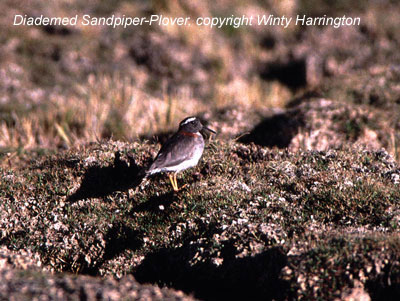
click here for more gen on Diademed Sandpiper-plover.
By the late afternoon we reached the spot to look for the Diademed Sandpiper-Plover. Goyo had the Diademed Sandpiper-plover within a few minutes and only 150 yards (m) from the van but we were at 15,000 feet (4500 m) so we took it easy getting to them. After half an hour or so we moved on going down in elevation to find a camping spot at lower elevation. Just after dark and at 13,000 feet (3900 m) we ended up camping out on the road. It was a cold night for us with temperatures getting down close to freezing.
In the afternoon we also picked up Andean Goose, Mountain Caracara, Gray-breasted Seedsnipe, Dark-winged Miner, Plain-capped and White-fronted Ground-tyrants, and Peruvian, Plumbeous, Ash-breasted, and Band-tailed Sierra-Finches.
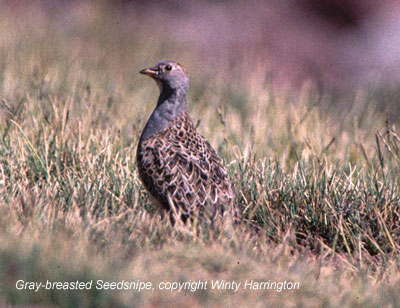
June 5th, Marcapomacocha
Up with the dawn with some birding around our campsite. A pair of
Rusty-crowned Tit-Spinetails were carrying food to a nest hole in the road bank a short distance away from our campsite. After breakfast and putting away our gear; we continued birding the area coming up Plain-breasted Earthcreeper, Black-billed Shrike-Tyrant, and a Torrent Duck. We continued down the valley to a spot where we could look for White-cheeked Cotinga far up the slope above us. Fortunately for us, a pair of White-cheeked Cotingas popped up just as we getting out of the van saving us a hard scramble up a steep slope. A good birdy spot so we spent a good half hour before turning around and returning to Lima. More time and light than the day before; so we slowed up passing several ponds along the way picking up Silvery Grebe, Crested Duck, and Giant Coot.
We stopped at the road junction where we were to look to for White-bellied Cinclodes. Goyo pointed to a stone hut a quarter mile (400 m) away saying we would find the cinclodes near it. We gave Goyo one of the walkie-talkies and he started out with Patty, Barbara, and myself slowly following. We were back up to 15,000 feet (4500 m) and the others decided to rest in the van. A few minutes later and a hundred yards (m) from the van Barbara pointed to a bird on the ground; presto, it was a White-bellied Cinclodes.

We aroused the group in the van and everyone getting excellent views. The cinclodes moved to within a few feet of the road with a total of three of them. Time to push on to a lower altitude and back to Lima before it was too late. A little before we reached the main road we stopped to look for Black-breasted Hillstar which took a little longer.
New birds for the day included Andean Condor, Black-winged Ground-Dove, Andean Flicker, Streak-throated Canastero, D'Orbigny's Chat-Tyrant, Puna Ground-Tyrant, Brown-bellied Swallow, Black Siskin, and White-winged Diuca-Finch.
June 6th, travel to Cusco, Huacarpay Lakes
Up early to go to the airport for a 7:30 am flight to Cusco. After picking up our luggage, we stopped at a grocery store for lunch and snack supplies. We then headed to Huacarpay Lakes arriving about 11 am. We spent most of the afternoon birding the lakes from the road and along the hills next to the lakes. Highlights included: Speckled and Puna Teal, Yellow-billed Pintail, Plumbeous Rail, Slate-colored Coot, Andean Lapwing, Andean Gull, Bearded Mountaineer, Rusty-fronted Canastero, White-browed Chat-Tyrant, Spot-billed and Rufous-naped Ground-Tyrants, Andean Negrito, and Yellow-winged Blackbird.
Two men were fishing on the lakes using their traditional reed boats. As we were leaving the area, we passed a farmer threshing grain in the middle of the road with donkeys. The road had been newly paved and apparently the new pavement provided a good surface to thresh grain. In the late afternoon we passed through Huambutio and headed down the Vilcanota/Urubamba valley to Yucay for the night.
June 7th, Abra Malaga, dry side
Today we did the dry side of Abra Malaga, which is the close side
so we slept in just a bit longer, but still another start in the dark. We
started birding once we reached the switchbacks with Chestnut-breasted Mountain-Finch and a very brief view of a Green-tailed Trainbearer at the first stop. An overcast day with some drizzle and light rain most of the day. We continued birding and driving until we reached the pass. We discussed walking over to the polypelis woodland but a cold wind driven rain was falling in the area so with the rain and altitude we bagged it. Highlights of the dry side included: numerous White-tufted Sunbeams, White-bellied Hummingbird, Great Sapphirewing, Creamy-crested Spinetail, Red-crested Cotinga, Sierran Elaenia, Rufous-breasted and Brown-backed Chat-Tyrants, White-capped Dipper, Great Thrush, Hooded Siskin, Spectacled Redstart, White-browed Conebill, Rust and Yellow Tanager, and Black-throated Flowerpiercer.
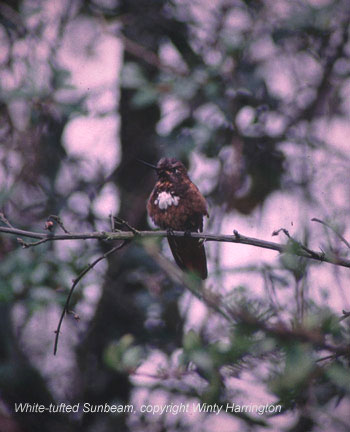
June 8th, Abra Malaga, wet side
We left early for the wet side of Abra Malaga with only a couple of brief stops on the way up. Our driver nearly drove off the road on the way up and we noticed he was getting sleepy again; so we stopped a kilometer or so before the pass, letting him take a short nap, and we birded on foot. Then on to the far side stopping when we reached treeline. There we starting hiking down along the road finding several nice mixed tanager-conebill-flowerpiercer flocks. Highlights of the wet side included: Violet-throated Starfrontlet, Sword-billed Hummingbird, Marcapata Spinetail, Unstreaked Tit-Tyrant, Pale-footed Swallow, Mountain and Inca Wrens, Blue-backed Conebill, Scarlet-bellied and Chestnut-bellied Mountain-Tanagers, Golden-collared Tanager, and Plush-capped Finch.
About 3 pm we encountered a stalled car blocking a stream crossing, so our driver being without jumper cables took his battery over to the other car to start it. We turned around taking it a little easier going down as yesterday we had a very rough ride down. After picking up our luggage in Yucay, we continued on to Cusco for the night. The day had been fairly wet with several good showers. We stayed at el Balcon hostel (http://www.el-balcon-hostal-cusco.com) on a quiet side street about three blocks from the main square.
June 9th, Cusco to Cock-of-the-Rock Lodge
Our big, heavy duty, bus picked us up at el Balcon hotel which is on a very narrow street. We were not quite ready the first time he came around so our driver had to go around the block when a couple of cars backed up behind him. We got most of the luggage loaded when several cars again backed up, so the last few bags were carried down to the end of the block. We left Cusco just before 7 am. Today will be a long travel day going overland to Manu National Park. We had originally planned to camp tonight near Tres Cruces and on to Cock-of-the-Rock Lodge tomorrow; but after our previous cold night camping and the wet weather, we asked if we could go straight to Cock-of-the-Rock Lodge. With a small extra fee, we could, so we took that option. Most of the drive was through very dry country with many small farms. At Paucartambo we took a short break, the driver told us to cross the bridge to the town square to see the fountain which had a dozen or so metal figures of mythical people. In addition, we were treated to the school drum and bugle marching band practicing for a parade tomorrow. At the river crossing in town we saw a Torrent Tyrannulet and Black Phoebe.
Thus far it had been an overcast day with no rain but as we neared the pass near Tres Cruces the rain started. We ate lunch at the pass hoping the rain would let up, but it would not. We tried birding in the rain, but few birds and the wind was blowing the rain into us so we gave up birding and continued on. By mid-afternoon the rain had let up and we reached an overlook of the valley and Cock-of-the-Rock Lodge. We stopped for photos and started birding down the road encountering several feeding flocks; the first of which had a beautiful male Andean Cock-of-the-rock, 2 Andean Guans, and a toucanet which we did not identify before it disappeared. Finally we were in tanager country with mixed flocks of Yellow-throated, Orange-eared, Golden, Saffron-crowned, Beryl-spangled, and Blue-gray Tanagers, Black-eared Hemispingus, and Orange-bellied Euphonia. After an hour we pushed on to the lodge arriving about 5:30 pm with just enough time to get settled in before darkness fell.
We were staying 4 nights at Cock-of-the-Rock Lodge planning to bird above and below the lodge along the road. There was a short trail below the lodge which went down to the river and a Cock-of-the-rock lek was a 10 minute walk up the road. No electricity here so we wrote our notes by candlelight. We stayed in the old section, which has very small cozy rooms and a separate bathhouse. Individual units were under construction and I understand were finished by late summer 2000.
June 10th, road from timberline down to Cock-of-the-Rock lodge
Up for a good breakfast of scrambled eggs, ham and peppers, toast, and juice for a 6:30 am start. While waiting for everyone at the bus; a feeding flock came through with Paradise, Silver-beaked, and Spotted Tanagers, Blue-naped Chlorophonia, Purple Honeycreeper, and Deep-blue Flowerpiercer new for the trip. We saw a Solitary Eagle, Social and Lemon-browed Flycatchers, and a Tropical Kingbird from the road before weleft as well. We went back up the road we came down yesterday. We stopped at 8050 feet (2450 m), where the good forest began, and started birding going down the road towards the lodge. We walked along the road, birding, encountered a number of feeding flocks and stopped birding at 6700 feet (2040 m) at 3:30 pm. We rode in the bus only a couple of times and for only short distances. We stopped at the overlook and walked down to the fruiting tree where we had the Andean Cock-of-the-rock yesterday but only an Andean Guan today. The day started out clear but clouded up becoming overcast late with some drizzle. By the time we reached the overlook we were in fog.
Besides the same birds we saw yesterday we added Long-tailed Sylph, Masked Trogon, Montane Woodcreeper, Streak-necked Flycatcher, White-tailed and White-banded Tyrannulets, White-winged Black-Tyrant, Peruvian Wren, White-collared Jay, Capped Conebill, Grass-green Tanager, Yellow-throated Bush-Tanager, Blue-capped Tanager, Hooded Mountain-Tanager, Blue-necked Tanager, Blue-and-black Tanager, Rufous-naped Brush-Finch, Mountain Cacique, and Dusky-green Oropendola.
June 11th, Cock-of-the-rock lek, trail, road below lodge
Up at 5 to go to the Cock-of-the-rock lek before breakfast. We stayed in the blind about an hour with 2-3 males performing along with an immature male and one female. In the dim light some Yungas Manakins flashed by; they proved to be a difficult bird to get a decent view of although they were always around the lek area. Also saw a Crimson-bellied Woodpecker from the blind as well. Great start to the morning and now back for breakfast. But we encountered a feeding flock on the way back so we were late for breakfast. After breakfast; we did some birding from the lodge, did a little laundry, and then took the trail down to the stream. Few birds until we came across a flock, but hard to see much because of the closed nature of the trail. At mid-afternoon we worked our way down along the road picking up Chestnut-backed Antshrike, Long-tailed Tyrant, Purplish Jay, Russet-crowned and Three-striped Warblers, and Magpie Tanager. Other highlights of the day included: Squirrel Cuckoo, Versicolored Barbet, Streaked Xenops, Stripe-chested Antwren, Streaked Flycatcher, White-thighed Swallow, Black-goggled, White-winged, and Bay-headed Tanagers, and Crested Oropendola. Near dark, part of the group saw a Fasciated Tiger-Heron fly down river. Weather much like yesterday; clear early, clouding up and a little rain late.
June 12th, road below Cock-of-the-Rock Lodge
Up early to go to the blind again but there was another group there when we arrived so I headed back for a shower and some birding next to the lodge. Breakfast was at a more normal time, 7:30 am. At breakfast a troop of Brown Capuchins came in to the trees next to the kitchen and waited for their morning bananas. We set off about 8:30 doing down the road to where we left off yesterday. As the first person started off the bus, we heard an eagle scream from behind the bus; it was an immature Black-and-chestnut Eagle perched in a tree 60 feet (20 meters) from the bus! Good start, but not much along the road. About an hour after lunch we talked about turning around when we heard some parakeets. Bamboo seeds were ripe and they were eating the seeds. Something stirred the parakeets up and we estimated about 300 White-eyed Parakeets. Some Blue-headed Parrots flew in as well as four Blue-headed Macaws. In the morning numbers of Military Macaws were lying back and forth across the valley. Other highlights of the day included: Greater Yellow-headed Vulture, Crimson-crested Woodpecker, Ash-browed Spinetail, Little Ground-Tyrant, Violaceous Jay, Russet-backed Oropendola, Black-faced Dacnis, Bronze-green Euphonia, and Golden-eared Tanager. Once back at the lodge we tried for the blind again, but found the lock was jammed so we could not use it. Andean Cock-of-the-rocks could be easily seen from the road next to the blind and we had another lek yesterday several kilometers below the lodge. A little below the blind we found a Black-streaked Puffbird. Weather was as the past two days with only a few drops of rain.
June 13th, travel day, Cock-of-the-Rock Lodge to Pantiacolla Lodge
Up early to finish packing and to bird along the road as far as the blind before breakfast. I finally got a half-way decent look at a Yungas Manakin. The usual mixed tanager flock was along the road so we got a final look at some of those knock-out tanagers such as Orange-eared, Golden, Golden-eared, Beryl-spangled, and Yellow-throated. The Brown Capuchins greeted us at breakfast time and we boarded the bus about 8:45 am. We had a couple of birding stops during our drive. Lunch stop was at a bluff overlooking Atalaya where we would be catching our boat. Winty had done a similar trip 2 years ago and they had an Orange-breasted Falcon at this spot but not this trip. On to Atalaya where we boarded our boat, a long thin wooden, flat-bottomed boat shaped like a canoe but wide enough for three to sit abreast. We had a two hour ride down the Alto Madre de Dios River to Pantiacolla Lodge.
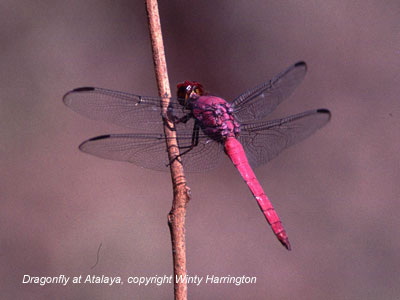
Nice selection of water birds which we would see almost everyday we were on the river; this included: Cocoi and Capped Herons, Great and Snowy Egrets, Roseate Spoonbill, Black Carcara, Bat Falcon, Large-billed and Yellow-billed Terns, Sand-colored Nighthawk, Swallow-wing, Drab Water-Tyrant, White-winged and White-banded Swallows, and Giant Cowbird. We also saw a couple of Fasciated Tiger-Herons and Black and Red-throated Caracaras from the boat. Roadside Hawks were so common along the river that we took to calling them riverside hawks.
We arrived at Pantiacolla about 3:30 pm, got our luggage to our rooms, and off on a short bird walk. We saw few birds but heard many more. We headed back when it started to rain as the light was fading as well. We saw a couple of Dusky Titi Monkeys on our return and stopped to watch a flight of Sand-colored Nighthawks from the river.
The cold water shower, no hot water available here, felt good as I was hot. It had been a hot and humid day as expected since we were now down to 1700 feet (520 m). Most of the housing at Pantiacolla is as duplex cottages with a small deck with chair and hammock. The rooms were large with two twin beds with mosquito netting. The walls were open between 4 feet (1.2 m) and the roof allowing good air circulation. In the center of the complex was nice dining room. Two adjoining bathrooms were off to the side. Dinner and note writing by candlelight.
June 14th, Pantiacolla lodge trail
Up early for a 6 am bird walk but it started to rain so we waited for breakfast at 7. By the time we finished breakfast, the rain had stopped. We did the Capybara Trail (2.5 km) getting back at 12:30 pm. After lunch Paul and Teresa got out their climbing gear and those who wanted did a short practice tree climb. Then off on a late afternoon bird walk, but like yesterday we did not see much. The group reported 107 species of birds today but nearly 60 percent were heard only; Paul has an excellent ear and lots of experience in trying to bring the birds in which worked in many cases.
Highlights of today included: 6 King Vultures circling the lodge after lunch, Mealy Parrot, Black-eared Fairy, Collared Trogon, Lemon-throated Barbet, Chestnut-winged Foliage-gleaner, Spot-winged Antshrike, Striated Antbird, White-cheeked Tody-Tyrant, White-winged Shrike-Tanager, and Yellow-crested Tanager.
June 15th, travel day, Pantiacolla Lodge to Manu Wildlife Center
Up early for a prebreakfast walk doing the Capybara Trail in reverse for nearly half a kilometer. Highlights included: Blue-crowned Trogon, Red-billed Scythebill, Bluish-slate Antshrike, Manu Antbird, female Blue-crowned Manakin, Large-headed Flatbill, and Pectoral Sparrow. Before we left we saw a Spix's Guan and 2 Casqued Oropendolas at the compound. The compound area was a great area for birds and Dusky Titi Monkeys as well.
We boarded the boat for a 5 hour trip down river to Manu Wildlife Center (MWC) on the Madre de Dios River. We arrived about 3:30 pm with only a brief stop to stretch our legs. After getting our luggage to our rooms we headed for the canopy platform at the top of a 144 step spiral staircase. Great view but not many birds as it was late in the day.
Birds along the river were about the same as on the 13th but we added Anhinga, Wood Stork, Jabiru, Pied Lapwing, Collared Plover, and Black Skimmer. Other birds added today include Scarlet Macaw, Cream-colored and Yellow-tuffed Woodpeckers (tower), and Thrush-like Wren. While on the river our boatmen spotted a Brown-throated Sloth in a tree close to the water and brought us around for a better view. We also saw a large snake swimming across the river.
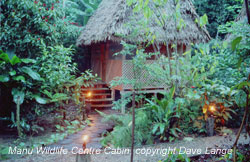 Very nice bungalows at MWC with a good sized screened room with two twin beds with mosquito netting. There was a nice table and stools, and our own bathroom with propane hot water. We had candles for light and beer bottle kerosene lighting for the walkways. The central dinning room is across the path from the kitchen and there is also a lounge with beer, wine and soft drinks available behind the kitchen. Very nice accommodations, which were the best of the trip. And we had a week to enjoy them.
Very nice bungalows at MWC with a good sized screened room with two twin beds with mosquito netting. There was a nice table and stools, and our own bathroom with propane hot water. We had candles for light and beer bottle kerosene lighting for the walkways. The central dinning room is across the path from the kitchen and there is also a lounge with beer, wine and soft drinks available behind the kitchen. Very nice accommodations, which were the best of the trip. And we had a week to enjoy them.
June 16th, MWC River Trail
Up early for a prebreakfast walk along the river trail to look for bamboo specialists. Paul taped in a pair of Goeldi's Antbirds, but we were less successful with other birds. It started to rain so we headed back arriving just before breakfast. We headed back along the river trail after breakfast. Paul called in a Greater Schiffornis which gave us brief views from several perches as it quickly moved from perch to perch in our limited field of view. Finally saw a White-browed Antbird, our first sighting although we have been hearing them for two days. Further along Paul tried to call in a Rusty-bellied Tapaculo; it came in close and Paul had a brief view but the rest of us did not even see movement. Some monkeys were making a lot of noise in the trees, insect eating monkeys, but we were not able to see them. Then it started to rain again and since it was noon, we headed back for lunch. We were about 2 kilometers out and fortunately Patty loaned me her umbrella as she also had a poncho. This was a serious rain and the trail was very slick by the time we got back. It continued to rain after lunch so we caught up on notes and some of us took a nap. Late in the day we went down to the landing; Large-billed Terns, a Snowy Egret, and a group of Sand-colored Nighthawks flew over the gravel bar. This would be our slowest day while at Manu with only 76 species of which 36 were heard only.
June 17th, Cocha Blanco, canopy platform, bamboo trail
Breakfast at 6 this morning and then a boat ride to the landing for Cocha Blanco, an oxbow lake. The cocha was about 0.5 kilometer away from the river. On the cocha there was a small catamaran consisting of two wooden canoes mostly covered by a large 9 x 12 foot (3 x 4 m) platform giving enough room for all of us.
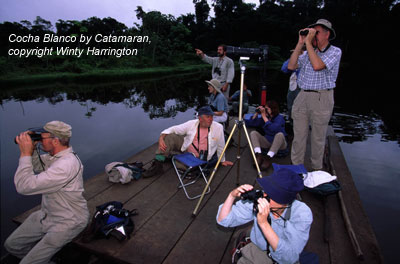
Our boatmen paddled us slowly around the cocha. We saw good numbers of water related birds including Green Ibis, Horned Screamer, Great Black-Hawk, Hoatzin, Wattled Jacana, both terns, Curl-crested Aracari, Lesser Kiskadee, a pair of Amazonian (Streaked) Antwrens, Band-tailed Antbird, and Black-capped Donacobius. We saw a pair of Giant River Otters on the cocha and Squirrel, Dusky Titi, and Red Howler Monkeys in the trees around the cocha. Along the river we saw 2 Capybara.
We got back to MWC about 11:30 am, so we headed to the canopy platform. There we added White-necked Puffbird, Broad-billed Motmot (our first seen), Cinnamon-throated Woodcreeper, and Spangled Cotinga. At lunch Winty got up and tapped his glass, he then announced that he and Bob had had a momentous occasion. They had decided not to go up to the canopy platform and had started down the other trail when a jaguar crossed the path in front of them! They rest of us were only a few hundred yards (m) away.
After lunch we got a ride across the river to explore the trails in another stand of bamboo. We reached the far side in a heavy rain shower, so we waited under our covered boat until the rain let up. The early part of our walk was very quiet and then a few birds shortly before we had to return. We added Scarlet-hooded Barbet and Pink-throated Becard to our list. This turned out to be our big day with 160 species seen or heard with one third heard only.
June 18th, bamboo across the river, Streamside Trail
Breakfast at 5:30 am so we could get an early start to go to the same area we birded yesterday afternoon. Very quiet this morning with the best sighting a Chestnut-capped Puffbird. Paul tried to tape in a number of birds but little luck. A Peruvian Recurvebill flew through the area several times but did not stop within sight. We returned to the lodge early as we were not having much luck. We then did a loop on the Streamside Trail before lunch. We added White-fronted Nunbird, Chestnut-eared, Lettered and Brown-mandibled Aracaries, Sooty Antbird, Sepia-capped Flycatcher, and Fulvous-crested Tanager to our lists.
Paul and Teresa climbed a big fig tree in the afternoon. The rest of us took it easy or birded close to the lodge. Overcast all day with some light drizzle from time to time but with little rain. Today was much cooler than our arrival three days ago, which was on a hot humid day. Each day has been cooler and more overcast. Nice to have brought long johns along for the cold high country days but they are proving useful in the lowland rainforest too.
June 19th, Cocha Camungo, research station, canopy platform
We meet at the landing at 5:30 am to go to the macaw lick. It was raining lightly and given that other groups were having little luck at the macaw lick we decided to forgo the macaw lick and go to Cocha Camungo. A steep, slippery landing but some Orinoco Geese flew in to greet us; a short distance up the trail two Masked Crimson Tanagers popped up, a nice start. We took the right trail ahead of our boatmen and the trail became very difficult with deep muddy ruts. The ruts had been made by a cart construction workers had been using to haul supplies for the foundation of a tower on the edge of the cocha. It was a long trail, maybe 2 kilometers or so to the landing on the cocha. There was a better trail which we missed by going ahead of our boatmen, but some of us used it on the return. A smaller catamaran was on this cocha; but we were able to crowd on with two people in the bow of each canoe, the boatmen with oars in the rear and the rest on the platform. We had drizzle to light rain the entire time we were on the water. The highlight was a Southern Tamandua (small anteater) which went up a small tree at the water's edge. The tamandua quickly came down and disappeared into the tall grass. New birds included Rufescent Tiger-Heron, Black-collared Hawk, Great Kiskadee, and Pale-eyed Blackbird. On our walk out we saw a Double-toothed Kite. Returning on the river we stopped at the research station and took one of the trails for half a kilometer. At one point we stopped, gathered around Paul as he was going to attract something in, when I saw a bird far up the trail. I quietly told the group to look up the trail as I brought my binoculars up to my eyes, it was a Great Tinamou. The Great Tinamou looked at us a couple of seconds and slowly disappeared around the corner. Further along there was an army ant swarm with several army ant specialists including Scale-backed Antbird, Black-faced Antbird, and White-chinned Woodcreeper. We stayed around for a while enabling each to see most of the species and hoping for more. When we came upon the army ants Paul had heard Pale-winged Trumpeters close by. They moved ahead and then came back giving us brief views. Back at the research station we had a nice mixed species flock adding Ocellated Woodcreeper and Guira Tanager.
We arrived back at the lodge at 3 pm, very late but we saw some excellent birds. We had a late, cold lunch and then out to the canopy platform for less than an hour before it started to get dark. From the platform we saw a male Black-tailed Trogon and Cinnamon-throated Woodcreeper well.
Overcast all day with a high temperature of 65 degrees F (18 C) and a low last night of 62 (17 C). Out of clean clothes and the ones I washed several days ago are not drying. We are all in the same boat wearing our warmest and cleanest clothes.
June 20th, MWC, River Trail
Up early to try for the macaw lick again but it had rained the second half of the night so we decided not to go. After breakfast we did our own thing with most of the group heading for the canopy platform. I birded by myself for awhile finding a nice understory flock with 6-8 species but I only got good views of 3, Bright-rumped Attila, Bluish-slate Antshrike and Black Manakin. A little further along I had great views of a Ruddy Quail-Dove. I came across a couple of canopy flocks which are hard to observe in the tall trees from the ground. But I saw White-fronted Nunbirds, White-winged Shrike-Tanager, Screaming Piha (not calling) and Cuvier's Toucan. A large brownish bird flushed from the forested bank which looked like another Great Tinamou. A Collared Peccary gave a short bark, we looked at each other for a couple of seconds and he disappeared into the undergrowth. I meet up with a part of our group and we worked our way back to the lodge.
After lunch Bob and I started down the River Trail when we came across an army ant swarm. I went back for to tell the others. Not a great number of army ant followers but Black-faced Antthrush, White-browed Antbird and the local lodge Pale-legged Hornero. Bob and I had started out to look for the monkeys seen by others yesterday and so we continued on. We went to the 1.7 kilometer marker before turning around. We were nearly back when we came across 6 Brown Capuchins and 3 Squirrel Monkeys. They were settling down for the night and quickly disappeared.
Another overcast day with drizzle or light rain falling most of the day. The temperatures stayed 60-62 degrees F (15-17 C) all day! Is this the tropics?
June 21st, Grid Trail, canopy platform
Another early wakeup to try for the macaw lick but it had started raining before dawn so none of us felt like moving too fast. Overcast and cool (15 C) like the past couple of days. Although it was not raining when we headed over to the dining hall, we decided not to go. Another group went to the lick and did not see any macaws. Early breakfast and then off to the grid trail system where we walked until lunchtime. Nice walk, no rain, some light wind which is very unusual in the rainforest and low numbers of birds but a few new ones. The army ant swarm was in nearly the same spot we left them last night. The Brown Capuchins and Squirrel Monkeys were also close to where we had last seen them and this time everyone got to see them. Further along on the grid system we saw a troop of Saddle-backed Tamarins and then some Brown Pale-fronted (White) Capuchins which I did not see. New birds for the trip included Chestnut Woodpecker, Red-necked Woodpecker which everyone saw, Plain-throated Antwren seen, Wing-barred Piprites, 2 Musician Wrens seen, Amazonian Oropendola, and an Ornate Hawk-Eagle heard circling overhead.
In the afternoon we all went to the canopy platform. It was our last day at Manu and the last day we would all be together. Paul and Teresa would be staying at MWC until late August climbing trees and studing the birds. Tomorrow the rest of us would start heading home with a day in Cusco and a day at Machu Picchu. We had two 10-minute periods of sunshine on an otherwise overcast sky and we all snapped pictures, mostly of the group. It was mostly a quiet time and a nice farewell to this part of the trip. We walked back to the lodge in the fading light listening to a Tawny-bellied Screech-Owl.
It felt much drier today but still very cool with a high temperature in the mid 60s (18 C). Writing notes at 10 pm my thermometer is reading 59 degrees (15 C). Some drying of clothes today but most of it is still wet from when it was washed when we arrived at MWC.
June 22nd, travel to Cusco, festival of Corpus Christi
We left MWC at 7:30 am going upstream 2 hours to the Boca Manu airstrip. Overcast with the usual birds along the way. We had a half hour wait at the airstrip picking up a Bran-colored Flycatcher and Double-collared Seedeater. Our plane, a Twin Otter, came out of the overcast sky and landed on the grass airstrip cut in the rainforest. We had a full flight and took off into the clouds. We popped out at 6000 feet (2000 m) into a clear sky, a long time since we saw that much sun. We landed 45 minutes later in Cusco on a cloudless day. After getting to our hotel, el Balcon, and having a lunch of chicken soup, we headed to the central square for the festival of Corpus Christi. The central square was only three blocks away, but it took us over half an hour to get there as we went down the food street, which was packed with people. We stood at the corner of the square watching the procession and taking pictures. One of group was videotaping a short distance away and felt someone touch his pocket, he reached down and checked for his wallet which appeared to be there. When he later checked, his wallet was gone; fortunately, he had removed most of his money before we went to the square.
In the festival of Corpus Christi, a statue from each of the churches in Cusco is carried to the central cathedral for a week long blessing. Each colorful statue is carried by a group of men proceeded by a band. We did a little shopping and then to dinner. Just as our main dish arrived; the fireworks started, so everyone in the restaurant including the waiters went into the street to watch the fireworks.
June 23rd, Machu Picchu
We did a day tour of Machu Picchu with few birds today but we did not devote any time for birding. From the train we saw Cattle Egret, 5 Puna Ibis, 10 Torrent Ducks, American Kestrel, 12 Andean Lapwings, Andean Gull, Rock Dove, Torrent Tyrannulet and a White-capped Dipper. We saw few birds around the ruins and no Inca Wren.
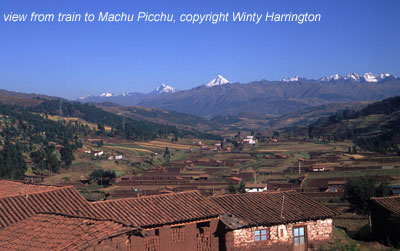
June 24th, flight from Cusco to Lima, Santa Eulalia valley
We had an early flight from Cusco to Lima where we put our luggage in storage as we had an evening flight back to the states. We had rest of the day to bird and we had arranged to have Gunnar Engblom (Kolibri Expeditions) take us back to the Santa Eulalia valley. Half of our group was not with us the first time and we would try to go higher. Gunnar's van was not available so he arranged a small school bus for us although the seating certainly not the best for those of us over 6 feet.
We went up the Santa Eulalia valley not stopping until we reached the spot we had the Black-necked Woodpeckers nearly three weeks ago. We waited around several minutes but no woodpeckers. Just as we were getting into the bus, we heard one call and the pair came into view. Then up beyond the San Pedro bridge for more birding picking up Harris' Hawk, Tropical Pewee, Rufous-chested Tanager, Rusty-bellied Brush-Finch, and Golden-bellied Grosbeak. The highlight was a Peruvian Pygmy-Owl perched out in the open about 60 feet (20 m) from the road. A second one was less than a kilometer away. The rest of the group was able to see most of the goodies we saw on the first trip. Time to head back to Lima and home.
Trip summary
In 22 days of birding we visited many different habitats of Peru including the dry coastal hills, puna, temperate rainforest and tropical rainforest. We saw or heard 577 species of birds of which 75 were heard only thanks to the Paul's excellent ears. We saw 18 mammal species including 7 species of monkeys and a night monkey was heard. The scenery was spectacular, the lodges and food excellent and the people wonderful.
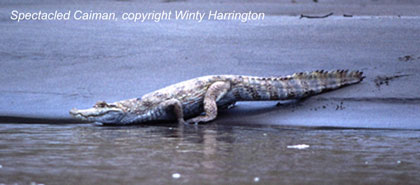
Field guides
Unfortunately there is no single field guide to the birds of Peru. A Guide to the Birds of Colombia by Hilty and Brown is the most useful and covers many of the species. We also used Birds of the High Andes by Fjeldsa and Krabbe which is very useful for species occurring in the temperate zone or higher (about 2500 m) and volumes I and II of The Birds of South America by Ridgely and Tudor which covers the passerines. An Annotated Checklist of Peruvian Birds by Parker, Parker and Plenge is also useful for habitat and abundance information.
Lodges
Links to the lodges we stayed at are as follows:
Cock-of-the-rock http://www.inkanatura.com/cockrock.htm
Pantiacolla Lodge http://www.inkanatura.com/pantiaco.htm
Manu Wildlife Center http://www.inkanatura.com/manuwc.htm
Epilogue
Paul and Teresa said the weather improved at Manu Wildlife Center the day we left and the week we were there was the longest cool spell they saw the rest of the southern winter (July and August). Paul and Teresa are returning to Manu Wildlife Center in May 2001 to begin construction of a 1.3 kilometer canopy walkway.
